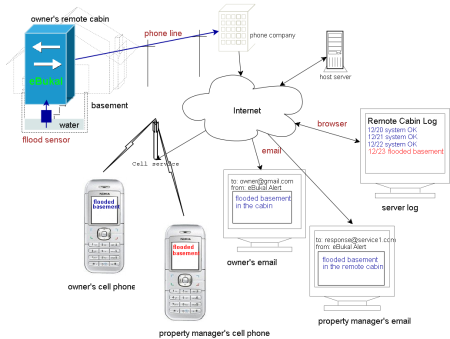Python Success Stories
Introduction
Internet connectivity is omnipresent, finding new applications and giving old designs a new lease on life. In this age of small IC devices boasting TCP/IP stacks and wireless connectivity, one no longer needs a standalone PC to harness the Web.
VAHNZ Controls developed its eBukal[1] remote alarm device to leverage their knowledge of microcontroller interfacing and Internet protocols, creating an innovative solution for the field of building automation.
Remote Event Dial-up Internet Notification
The idea grew out of one client's need to monitor the temperature of an office building's air conditioning during one long hot summer in Portland. The office property manager wanted to be alerted before the temperature in offices became unbearable and the tenants complained. The application is not limited to only detecting temperature changes, but has been used with a variety of input devices such as proximity switches and flood sensors.
Version one of the design used DTMF tones to leave the numeric message on the office manager's phone. Besides the crudeness of deciphering the meaning of the digits, the calling device also had to negotiate the timing pitfalls in the recipient's voicemail system to select the one option for leaving the digital feedback. The resulting system was neither robust nor pretty.
Text messaging seemed to be the right way to go, because messages are easily received by any mobile phone. Most wireless providers maintain email to SMS gateways, and many off-the-shelf devices can generate email messages. I was only limited by the necessity of dial-up connectivity -- many locations containing monitored equipment proved impervious to wireless signals.
After coming up with the basic idea to use text messages and selecting the components, I had to figure out how to make the individual parts work together.
Email messages coming from the eBukal device had to be parsed on the server to determine the recipient(s) to be notified and the online logbook that should receive the entry. New devices had to be added to the configuration file. Parameters such as the threshold, phone number to dial, and so forth, had to be sent to eBukal via serial port. A graphical user interface (GUI) had to be written to enable personnel in the field to set the device.

How eBukal is used to monitor water conditions in a basement Zoom in
I knew how to write command line scripts and PHP to do the server coding and used Perl for CGIs and Visual Basic for the GUI, but I wanted to do it better this time. I wanted to do it right.
Python - one stop shopping development plus platform independence
I used Python before and it seemed to have the potential to do all the required coding and was a programming language that I enjoyed using. I was not entirely confident about some parts of the task, especially building a graphical user interface, but decided to face my fears, trusting to Python's maturity, powerful libraries, and third-party support. The SPE editor together with Python's interpreted nature proved especially valuable.

Screen shot of the eBukal messaging configuration user interface, based on wxPython
After some trial and error I settled on the final concept using the following standard library and third party modules:
- email, time, and ConfigParser -- for email parsing, phone message generation and log book entry on the server side
- cgi and sha -- for a CGI module to edit the server configuration file
- wxPython and wx.xrc -- for the GUI written in XRCed
- serial, pickle, ConfigParser, and time -- for the serial-communication library for eBukal setpoint download
Unfortunately there is no PIC compiler using Python syntax; if such a tool existed, the circle would have been completed. As a result, the microcontroller code is written in PicBasic Pro, a popular commercial product from MicroEngineering Labs, Inc.

Screen shot of the online log of events from eBukal, with alerts in red and informational messages for daily diagnostics Zoom in
The gamble paid off. The system works well and many bells and whistles could be added: A server logging feature, daily diagnostics, and online configuration. Python delivered more than I was asking, and some features were added based on availability of the functionality in the library modules being used.
Summary
This may not yet be VAHNZ Controls' killer application, but I feel that the selection of the Python programming language is a move in the right direction. Technology is always evolving and no one knows what comes next, but I am confident that Python will be there ready for the challenge. Platform independence is another aspect to feel good about -- betting all the chips on one player might be riskier than ever in today's climate.
For more information, visit VAHNZ Controls on-line at eBukal.vahnzcontrols.com or contact info at vahnzcontrols.com.
About the Author
Ivan Lehecka is founder of VAHNZ Controls, a company that strives to bring intelligence to building automation and other fields, where suitable.
| [1] | eBukal is a trademark of VAHNZ Controls. |
